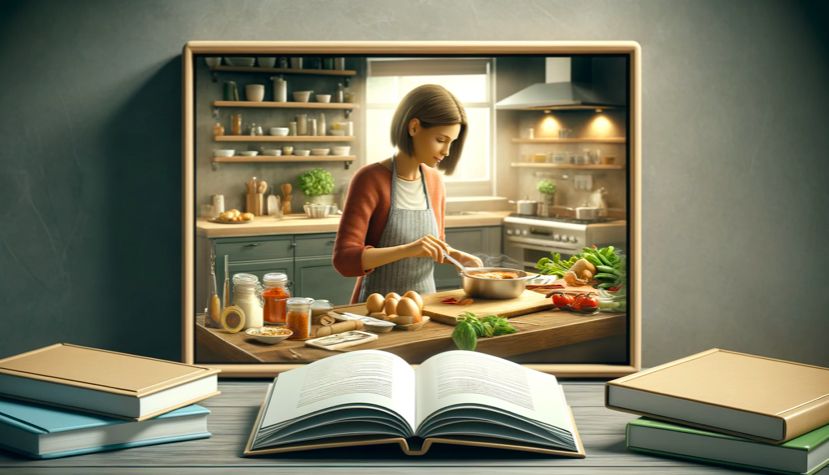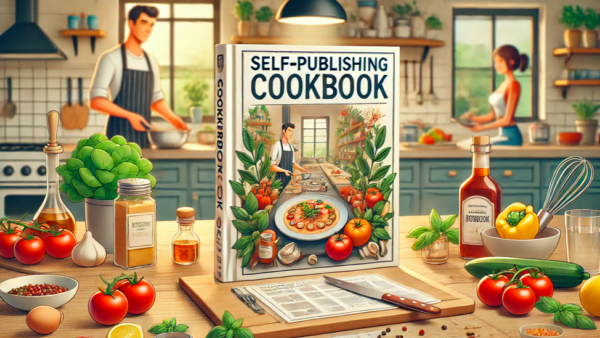In recent years, the publishing landscape has dramatically transformed, with self-publishing emerging as a powerful avenue for authors across genres. Chefs, home cooks, and food enthusiasts are increasingly choosing to self-publish their cookbooks to directly reach their readers, bypassing traditional routes to bring their culinary creations directly to readers. Self-publishing a cookbook not only offers the freedom to tailor every aspect of the book—from the recipe selection to the design and photography—but also enables authors to directly connect with their audience- ensuring their authentic voice is not lost in the editing process.
Furthermore, it provides significant financial benefits, allowing authors to retain all the money from the sales, which is often the lion’s share of the profits. This article delves into why self-publishing your cookbook could be a delicious opportunity to share your culinary expertise while maintaining creative control and maximizing earnings.
Your Publishing Journey Awaits – Start NowUnderstanding Self-Publishing
Self-publishing refers to the process whereby authors publish their work independently, without the intervention of a traditional publishing house. This approach enables authors to maintain complete control over every aspect of their book, from the content and cover design to the marketing and distribution strategies. Unlike traditional publishing, where a publishing house often takes charge of these processes, self-publishing places all responsibilities—and rewards—directly in the hands of the publisher and author.
The key distinction between self-publishing and traditional publishing lies in the degree of control and potential financial return. In traditional publishing, authors submit their manuscripts to publishing houses, which, if interested, take over the roles of editing, designing, marketing, and distributing the book. Although this can significantly ease the author’s workload, it also means sharing a substantial portion of the book sales revenue and losing some creative control over traditionally published books. In contrast, self-publishing allows authors to retain the lion’s share of revenues and make all creative decisions, which can be particularly appealing in niche markets like cookbooks. This highlights the control and financial benefits of self-publishing over being traditionally published.
The self-publishing process involves several key steps: authors must write their content, design the book, manage the printing (if producing printed books), and handle distribution, often relying on platforms that offer print-on-demand services. Digital tools and online platforms have streamlined these tasks, making it easier than ever for individuals to publish their own cookbooks and reach their target audience directly. For those looking to dive into self-publishing, understanding the roles traditionally played by publishing houses can provide valuable insight into the tasks they will need to manage on their own.
Advantages to Self-Publish Your Cookbook
One of the most compelling reasons to self-publish your cookbook is the unparalleled control it offers over every element of the book’s creation and presentation. Self-publishing authors make all the decisions—from the title of each recipe to the overall design of the book cover. This autonomy ensures that the cookbook truly reflects your vision and culinary style, without compromise.
For those passionate about presenting their recipes in a particular way, this means the ability to include detailed instructions, vibrant color photos, and personalized design elements that align with their brand or aesthetic preferences. Publishing your own cookbook not only amplifies this personal touch but also opens up the possibility to distribute it across various formats, including PDF, Kindle, iBook, and printed versions, maximizing your revenue potential.
Additionally, self-publishing significantly accelerates the process of getting your book into the hands of eager readers. Unlike traditional publishing, which can involve lengthy periods of pitching, contract negotiation, and a fixed publication schedule, self-publishing allows you to move from manuscript to market in a fraction of the time. This swift timeline not only caters to current market trends and seasonal cooking but also enables authors to capitalize on emerging food movements or dietary fads.
Financially, self-publishing offers substantial benefits. By bypassing traditional publishers, authors avoid the typical royalty-sharing model, instead retaining all profits generated from book sales. This direct-to-consumer model is particularly lucrative when paired with sales platforms that cater to self-publishers. Publishing a cookbook online further enhances these benefits by offering higher royalties and the ability to distribute the book through e-book and Kindle services, with services like BookBaby providing book printing templates and an online book project configurator for creating and selling cookbooks online.
Modern self-publishers can also choose from various printing and distribution options. Print-on-demand (POD) services allow authors to print books only as they are sold, which minimizes upfront costs and eliminates the need to manage large inventories. Alternatively, ebook formats cater to a growing audience who prefer digital content, which can be produced and distributed with even lower overhead costs.
By leveraging these advantages—creative control, speed to market, higher profit margins, and flexible printing options—self-publishing your cookbook not only allows for a highly customized product but also offers a financially and personally rewarding experience.
Your Publishing Journey Awaits – Start NowCase Studies: Successful Self-Published Cookbooks
Self-publishing has proven a successful route for many food enthusiasts who transform their culinary passions into popular cookbooks. Ella Woodward, better known as Deliciously Ella, began her journey as a food blogger. Her focus on plant-based recipes garnered a massive following, which she leveraged to self-publish her first cookbook. The success of “Deliciously Ella” was astounding, quickly becoming the fastest-selling debut cookbook in the UK, illustrating how a strong online presence can be converted into publishing success. Additionally, the printed book format of “Deliciously Ella” significantly contributed to its sales, highlighting the importance of offering cookbooks in both digital and printed versions to maximize reach and revenue.
Similarly, Ree Drummond, also known as The Pioneer Woman, utilized her blog as a launching pad for her cookbook series. Her blog, which originally documented life on a ranch, included family recipes that resonated with a broad audience. Her self-published books, such as “The Pioneer Woman Cooks: Recipes from an Accidental Country Girl,” became bestsellers, showing the power of relatable content and the appeal of authentic, family-oriented recipes.
These cases highlight the significant advantages of self-publishing for food bloggers and recipe collectors. By directly engaging with their audiences and retaining control over the publication process, these authors have not only fulfilled personal ambitions but have also established themselves as influential figures in the culinary world. Their success underscores the potential of self-published cookbooks to reach and influence a wide readership, turning personal passion projects into major culinary trends.
The Technical Side of Self-Publishing a Cookbook
Self-publishing a cookbook involves several key technical steps, each critical to producing a professional and marketable final product. The journey begins with the meticulous writing and collection of recipes, where precision and clarity are paramount. This initial phase often involves testing and retesting recipes, ensuring that they are foolproof and easily replicable for readers.
Once the recipes are finalized, the next step is formatting the book. This includes deciding on the layout, where emphasizing the recipe title on the left page, accompanied by an image of the completed recipe and a brief description, becomes a popular and easy-to-follow formatting technique. Choosing fonts and placing images in a way that makes the cookbook both easy and delightful to use is crucial. Many authors opt to create both a PDF version for digital distribution and print copies for traditional cookbook enthusiasts. Print-on-demand services can be particularly useful here, allowing authors to print physical books as orders come in, thus reducing the risk and overhead associated with large print runs.
Professional copy editing is crucial in this process to ensure that the text is free from errors and that the instructions are clear. A copy editor who specializes in cookbooks can also offer insights into how to structure recipes and content to make them more user-friendly. Equally important is the cookbook’s cover design, which must be visually appealing to stand out in a crowded market. An attractive cover not only draws attention but also conveys the book’s style and essence at a glance.
For distribution, self-publishers have numerous channels at their disposal. Beyond selling directly through personal or book-specific websites, authors can utilize online sales platforms like Amazon, Barnes & Noble, and others that cater to both eBooks and printed books. These platforms can vastly expand an author’s reach, making the cookbook available to a global audience. Additionally, authors can take advantage of social media and food blogging networks to promote their books, engage with potential buyers, and drive traffic to their sales channels.
Navigating these technical aspects effectively not only ensures a high-quality cookbook that readers will cherish but also maximizes the author’s potential for success in the competitive culinary publishing market.
Your Publishing Journey Awaits – Start NowMarketing and Selling Your Self-Published Cookbook
Marketing a self-published cookbook effectively begins with a clear understanding of who your audience is. Identifying and targeting the right readers—whether they are enthusiasts of specific cuisines, followers of dietary trends, or fans of a food blog—ensures that your marketing efforts are focused and impactful. This strategic targeting helps in crafting messages and choosing marketing channels that resonate best with potential buyers.
Once the target audience is defined, leveraging social media is an essential strategy. Platforms like Instagram, Facebook, and Pinterest are particularly effective for food-related content due to their visual nature. Sharing high-quality images of recipes, creating engaging cooking videos, or offering sneak peeks of the cookbook’s content can stimulate interest and interaction. Additionally, regular updates and interactive posts can keep the audience engaged and encourage shares and likes, increasing visibility.
Food blogs also play a critical role in the marketing strategy. Regularly posting recipes from the cookbook, sharing behind-the-scenes stories about the book’s creation, and offering special promotions can drive traffic to your sales channels. Collaborations with other food bloggers can expand your reach, tapping into their audiences as well.
Participating in local events, such as farmers’ markets, food festivals, and cooking demonstrations, provides an opportunity to showcase the cookbook directly to potential buyers. These events allow for personal interactions, giving a face to the name behind the cookbook, which can be a powerful selling point.
To enhance sales further, consider offering both printed books and ebooks to cater to different reader preferences. Running promotions, like limited-time discounts or bundled offers, can also significantly boost sales volume. By employing these targeted marketing tactics and actively engaging with your audience, you can maximize your reach and sell thousands of copies of your cookbook.
Conclusion: Self-Publishing a Cookbook
Self-publishing a cookbook offers a unique set of advantages that can be incredibly rewarding for those looking to share their culinary passions with the world. By choosing to self-publish, authors retain complete creative control over every aspect of their book, from the intricacy of the recipes to the aesthetics of the cover design. This autonomy allows for a personalized touch that truly reflects the author’s vision and culinary philosophy. Additionally, the higher profit margins, direct connection with the audience, and faster time to market are significant benefits that traditional publishing routes often cannot match.
For anyone contemplating the creation of their first cookbook, the journey of self-publishing is one worth embarking on. It allows culinary artists to craft a product that is wholly theirs, while also offering the satisfaction of managing the entire project. Embrace the process, revel in the creativity it unleashes, and enjoy the direct bond it creates with your readers. Your unique culinary voice deserves to be heard, and self-publishing your cookbook is a profound way to make that happen.
Spines
Have you completed your manuscript and are ready to share it with the world? Spines stands as your gateway to the publishing realm, embodying the future of publishing. Our AI-powered platform is designed to revolutionize your publishing journey, offering a suite of comprehensive services. These include detailed editing and proofreading, captivating cover creation, seamless distribution, and strategic marketing across various channels and platforms. With Spines, your book is not only set to transcend the ordinary but also to make a significant impact in the new era of publishing. Sign up for free to start your self-publishing journey.
Your Publishing Journey Awaits – Start Now







